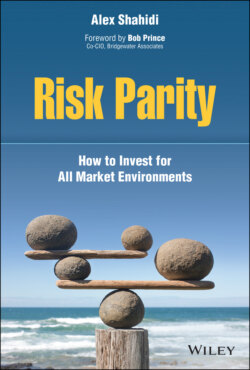Читать книгу Risk Parity - Alex Shahidi - Страница 22
THE 60/40 PORTFOLIO IS NOT WELL‐BALANCED
ОглавлениеThe conventional “balanced” portfolio is made up of 60% stocks and 40% intermediate‐term bonds. This allocation is commonly used in finance books and the media as a representation of a typical portfolio. In fact, there are hundreds of professionally managed strategies that benchmark to the 60/40 portfolio and use “balanced” in their title. However, a simple high‐level risk analysis using the definition just presented will reveal that the 60/40 portfolio is actually very poorly balanced.
The 60/40 portfolio scores poorly across the three dimensions of risk just described. The level of volatility is greater than necessary for the expected return. This point will become more apparent when I describe the risk parity portfolio later in the book. This conventional balanced allocation is also prone to significant losses and long stretches of underperformance, since its returns are almost entirely dependent on the stock market, which serves as the core return driver. A statistic that surprises many investors is that a 60/40 portfolio is over 95% correlated to a 100% equity allocation. For instance, the 60/40 portfolio experienced steep declines along with equities during the first quarter of 2020 (–12%) and during the Global Financial Crisis of 2008–2009 (–35%), and it grossly underperformed most investors' objectives during the entire decade of the 2000s (earning less than 3% per year and falling slightly behind cash over 10 years) as global stocks suffered negative returns for 10 years. Regardless, few practitioners raise concerns about the lack of balance in the 60/40 portfolio, and even fewer argue that the typical “balanced fund” is effectively engaged in false advertising.
In my experience, most investors don't really appreciate what diversification means. There appears to be an overemphasis on the number of line items as opposed to how diversifying each investment is relative to other holdings. They may think that they are diversifying by allocating to assets with slightly different characteristics or to funds with different managers (e.g., US small‐cap equities, US large‐cap, Vanguard, Fidelity, etc.), but all of those allocations tend to be highly correlated to each other. In other words, the differences many investors focus on are largely immaterial. As a result, they allocate to assets that all behave more or less the same way and barely diversify each other at all.
If the 60/40 portfolio is so poorly balanced, then how did it become the conventional balanced portfolio? A description of how this allocation evolved to become the convention and the thought process that backs its construction is warranted. The logic makes perfect sense, which explains why it has prevailed, and its place atop the balanced hierarchy has rarely been challenged.
We must go back to the story of Ray and his view that the starting point for most people is where others left off as opposed to a full reexamination of the central assumptions. When investors look to build a portfolio, they consider a menu of options. The typical choices include various equity and fixed income segments, because stocks and bonds represent the backbone of finance. Companies generally issue equity or debt to raise capital, and investors have the opportunity to own a piece of each in order to participate in the prosperity of the global economy. Throw in a strong bull market over the past decade and a remarkable run for both asset classes during the 1980s and 1990s as interest rates declined, and we can see why stocks and bonds as core menu options have persisted for so long.
Stocks offer high expected returns with high risk. Traditional fixed income such as intermediate‐duration government and high‐quality corporate bonds have lower anticipated returns with lower risk. With these two choices, investors can scale the risk of their portfolio up and down by adjusting the allocation between these two major asset classes. Those who have a high threshold for risk and/or a long time horizon may opt for 100% stocks, whereas investors who are more concerned about protecting principal may go all the way to 100% bonds. Nearly everyone will fall somewhere in between these two extremes, with the typical investor allocating 60% to stock and 40% to bonds because the risk level of that mix appears palatable for the majority.
The 60/40 portfolio has an expected return somewhere between stocks and bonds. An increase in equities above 60% yields a higher expected return, with a maximum long‐term return achieved at 100% equities. A reduction in stocks below 60% lowers the return projection all the way down to the estimate for bonds for risk‐averse investors who own 100% fixed income. The risk of these portfolios also scales up and down commensurate with the target return level. With this menu of choices, this is a very reasonable way to manage a portfolio.
A commonly used shorthand for determining the right allocation is to take 100 minus your age and allocate that amount to equities, with the remainder going to bonds. Following that rule of thumb, a 70‐year‐old should put 30% in stocks, while a 30‐year‐old, who has more time to ride the ups and downs of the stock market, can accept the greater risk that comes with a 70% equity portfolio as compensation for the higher long‐term return. If you're 30 and saving for retirement, there's a good argument to invest a majority of your portfolio in stocks if you're limited to these options. Although professional advisors may debate the percentages, few would argue with this general framework. The problem is that this logical sequence leads investors down a path that often results in poorly balanced portfolios that take unnecessary risk.
